Apple HomePod mini vs Apple HomePod: what’s new with the Siri smart speaker?
Should you buy the new HomePod mini over it’s older sibling?

[Update: Having first gone on sale at the start of 2018, the Apple HomePod smart speaker is now being discontinued, with Apple turning all of its attention to the smaller (and cheaper) HomePod Mini instead.
After the space gray HomePod was noted to be out of stock in the US, Apple confirmed to TechCrunch that the model was being discontinued. Once stocks have been exhausted, that will be that for the original Siri-controlled speaker – for now, you may still be able to find it.]
The Apple HomePod is one of the best-selling smart speakers in the world, and since its release in 2018 it’s represented an alternative to the likes of the Amazon Echo and Google Nest speakers for those who love the Apple ecosystem.
Part of the HomePod's success was down to its fantastic sound quality and understated design – but it wasn’t without shortcomings, and the built-in voice assistant Siri couldn’t compete with the smart home integration offered by Alexa and Google Assistant.
That’s why rumors of a new and improved HomePod were so compelling – and two years on from the original’s release, the company announced the Apple HomePod mini at its iPhone 12 launch in October 2020.
Smaller and cheaper than the original HomePod, the mini is designed to “act as the brain of your smart home” according to Apple, and it comes with an all-new design and nifty features like the ability to cast voice messages to Apple devices – including AirPods – in your home.
So, is it worth upgrading to the HomePod mini if you already have the original Apple smart speaker? Or, if you’re looking to invest in your first wireless speaker, which one should you buy?
Get daily insight, inspiration and deals in your inbox
Get the hottest deals available in your inbox plus news, reviews, opinion, analysis and more from the TechRadar team.
- Apple HomePod mini review
- Read our Apple HomePod review
- The best smart speakers of 2020
What’s new with the Apple HomePod mini?
The Apple HomePod mini is the long awaited successor to the original HomePod; smaller, cheaper, and coming with enhanced compatibility with the Apple ecosystem, it could be a compelling alternative to its bigger predecessor.
Price
One of the biggest changes with the new HomePod mini compared to its predecessor is its price; it costs $99 / £99 / AU$149, which is far cheaper than the original HomePod, which cost $349 / £319/ AU$499 when it launched in 2018.
Now that the Apple HomePod is a little older, it can usually be found at a discount – though now it's been discontinued, you can expect stock to dwindle pretty quickly.
The HomePod mini’s low price did come as something of a surprise; after all, Apple isn’t exactly known for being budget-friendly, and it puts it in direct competition with the new Amazon Echo and the Google Nest Audio, which both cost $99.99 / £89.99 / AU$149.
Design
The Apple HomePod mini looks like a squatter version of the HomePod, with a more rounded build that’s pretty similar to the new Amazon Echo.
It’s far smaller than its predecessor at just 3.3 inches tall, but it shares the same wraparound fabric grille and touch-sensitive control panel on the top, and it’s available in the same white and space gray colors.
So, if you’re looking for a compact desk buddy, or a smart speaker that will sit comfortably on your kitchen counter or bedside table, the HomePod mini is probably your best bet.

Audio performance
For us, the audio performance is the key reason to buy the HomePod mini. It's excellent for a speaker that's so small, and it really feels like the right mix of value for money and sound quality. The bass isn't too heavy, vocals aren't lost in the mix, and when you pair two minis, the stereo experience is really immersive.
Inside the HomePod mini is the new S5 chipset, which enables ‘computational audio’ according to Apple – in other words, the HomePod will analyze the song that’s playing and alter the response of the speaker accordingly.
The ability to tweak the audio output on the fly to improve the sound quality in real time, plus the use of a full-range driver and two passive radiators, makes for very impressive performance indeed – and the results speak for themselves.
The HomePod is even more powerful than the HomePod mini, containing seven tweeters and a separate woofer compared to the single driver that acts as a woofer and a tweeter inside the smaller speaker. Saying that, you can pair two HomePod minis for stereo sound – and it’s far cheaper to buy two of these than two of the original HomePods.
Both speakers are pretty limited in terms of music streaming, if you don’t have an Apple Music account. You can't ask the HomePod mini to play anything through Spotify – that can only be enabled through AirPlay, and requires using your phone rather than the simpler method of asking Siri to play tunes with your voice. Essentially, you'll need a subscription in order to make full use of your HomePod mini.
Music handoff is a new feature that you won't find on the bigger HomePod, as it uses the Ultra Wideband chip, the same one as those inside the iPhone 11 and iPhone 12, to know when one of those phones is being pointed at it.
Get close, point your music-playing phone at the HomePod mini, and a little rumble will tell you the music is now playing on the speaker. To 'steal it back', simply repeat the procedure and it'll come off the small HomePod and onto the phone again.
It's a really neat process, and one that will delight those who want to just pass music like it's magic (or can't be bothered fumbling around looking for the AirPlay icon to play their music on a speaker).

Connectivity
There are some connectivity features that come with the HomePod mini that make it an attractive proposition over the original HomePod.
The original HomePod offered great compatibility with Apple’s ecosystem, and this is taken even further by the smaller smart speaker.
For example, you'll get personalized listening suggestions on your iPhone when it's next to your Apple HomePod mini, as well as the ability to control the HomePod without unlocking your phone.
The Apple HomePod mini comes with the company’s voice assistant Siri built-in, just like its predecessor – and any upgrades that come with the HomePod mini will be available on the original HomePod, too.
These upgrades include the ability to identify who in your household is speaking to Siri, as well as the ability to tailor music and podcasts to their preferences. Siri Shortcuts created on your iPhone will also be available on the HomePods, which means you can ask it do things like add milk to your grocery list.
Siri can also play ambient sounds like rainfall to help you relax, help you find missing devices with the Find My feature, set music alarms, and deliver web results from voice searches straight to your iPhone.
With Siri built in, you can use the HomePod mini to control your smart home devices, whether you want to turn off your smart lights or change the temperature with your smart thermostat – however, one of the big bugbears with the Apple HomePod is the fact that it just doesn’t have the same capacity for smart home control as Alexa and Google Home devices.
We found this to be the same with the HomePod mini. Getting devices to pair with your smart setup isn’t too hard (although there are a few steps to go through), but so often we were met with the equivalent of a virtual shrug when trying to turn our smart devices on and off.

What about the Apple HomePod?
The older Apple HomePod was given two new features of its own – one shared by the the HomePod mini, and one exclusive to the larger smart speaker. These new features make it all the more surprising that the HomePod has now been discontinued. However, if you can still find the original Apple smart speaker, you'll be able to use these new features:
Intercom
Announced alongside the HomePod mini is a new feature called Intercom, and it’s available on the original HomePod, too. The feature allows the Apple HomePod to double up as an intercom system for your home, letting you send voice messages to other HomePods, iPhones, iPads, CarPlay, and even AirPods. This feature is available for the HomePod mini too, so if you want to create a cheap intercom system and already have a larger HomePod, we’d recommend buying the more budget-friendly Homepod mini to complete your setup.
Dolby Atmos
One new feature that's to be exclusive to the older HomePod is the ability to function as a surround speaker in 5.1, 7.1, and Dolby Atmos spatial audio – it’s expected to come via a software update in the coming weeks.
It’ll work if you’ve only got a single speaker, but placing one on either side of your TV will enable the full ‘spatial sound’ experience that you get from Atmos, where it places you as an object in the soundscape and fires the noise all around.
If Dolby Atmos is a dealbreaker and you want to use your smart speaker as part of your home cinema setup, we’d recommend going for the older HomePod for this reason – it’s sonic heft and ability to create a virtual surround sound experience means it’s the best speaker for the job.
Of course, the HomePod mini works in stereo if you buy two, so that’s an option if you’re on a stricter budget.

Takeaway
The Apple HomePod mini is an excellent addition to Apple's smart speaker family – though now, it looks as though it will be the brand's only smart speaker for the time being.
It may not share the same audio heft as the original HomePod, but the mini can certainly hold its own sonically, while the ability to stereo pair means you can boost the sound without the enormous cost of buying two original HomePods.
If sound quality isn’t your main concern, the Homepod mini could well be a great way to control your smart home and listen to some tunes in the process, especially if you’re furnishing a smaller space.
The same is true if you want to add Siri to a smaller room in your home and you already have the original HomePod – the new Intercom feature means your entire home can be connected, and there’s no need to spend the money on the larger HomePod if you’re just looking to bring smart connectivity into an additional room.
However, if sound quality is everything to you, the larger HomePod is likely to be your best bet, thanks to its impressive driver array, clever automatic audio adjustment, and upcoming support for Dolby Atmos. Sadly, it doesn't look like you'll be able to buy it for long, so you should snap one up now if you're keen.
- Read our Apple AirPods Max review
Olivia was previously TechRadar's Senior Editor - Home Entertainment, covering everything from headphones to TVs. Based in London, she's a popular music graduate who worked in the music industry before finding her calling in journalism. She's previously been interviewed on BBC Radio 5 Live on the subject of multi-room audio, chaired panel discussions on diversity in music festival lineups, and her bylines include T3, Stereoboard, What to Watch, Top Ten Reviews, Creative Bloq, and Croco Magazine. Olivia now has a career in PR.

